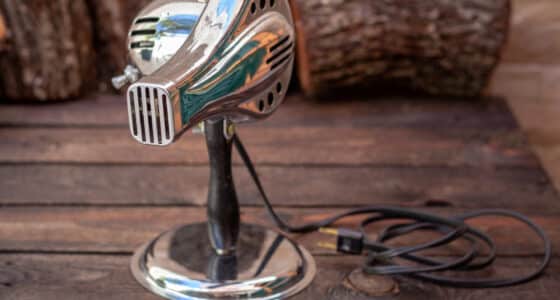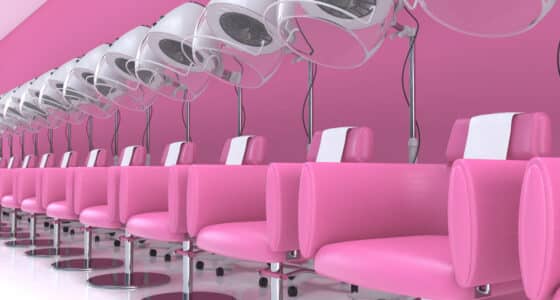Hair stylists and barbers are low on the list of occupations most people think of as hazardous, but their work during the 1970s and early 1980s put them at significant risk. That’s because the handheld and hood-type hair dryers that are the tools of their trade were insulated with asbestos, and the talcum powder used to brush hair from the necks of clients was also contaminated with the carcinogenic material. Decades after many retired from the field, these professionals are being diagnosed with malignant mesothelioma and other asbestos-related diseases.

How Do Hairdressers and Barbers Get Exposed to Asbestos?
Hairdressers and barbers were exposed to asbestos from two distinctly different sources. The hair dryers that they used as part of the styling process were insulated with asbestos and contained many asbestos-containing parts. They also used talc-based powders that were contaminated with asbestos to absorb moisture as they brushed cut hair from clients’ necks and shoulders after their service was complete. Many of the most popular brands of talcum powder used in beauty parlors, salons, and barber shops have been identified as having been contaminated with asbestos.
The Danger of Asbestos Fibers
Asbestos is a mineral that has proven to be remarkably useful in applications requiring strength and insulation against heat and fire. But after centuries of use, asbestos was discovered to be a carcinogen. When the fibrous mineral breaks down, its microscopic particles can get stuck in the cells surrounding the organs in the chest and abdominal cavity. Once embedded in these cells, asbestos causes mutations that can lead to serious illnesses including asbestosis, COPD, asbestos-related lung cancer, and the deadly form of cancer known as malignant mesothelioma.[1]
Asbestos in Handheld and Bonnet Hairdryers
Hairdryers may be thought of as modern appliances, but they were first used in 1888. By the early 1920s, the first handheld, gun-shaped model was introduced in the early 1920s, and hooded models were introduced in the 1930s. Originally made from metal or Bakelite, like many other appliances they were eventually made with more lightweight plastic bodies.[2]
Despite their apparent harmlessness, early hairdryers posed several health threats. They were unregulated and users were subject to electrical shocks that were later addressed with the installation of ground fault circuit interrupters, but the risk of electrocution was not the only hazard these appliances posed.[2] Shortly after it was discovered that asbestos was a carcinogenic material it was revealed that many handheld and bonnet-style hairdryers had been insulated with the material.

In 1979, the United States Consumer Product Safety Commission ordered nine major manufacturers of hair dryers to provide it with comprehensive information on the use of asbestos insulation in their products and asked the companies to send representatives to meet with its staff to prepare a response to the health threat posed by the dryers to both consumers and the professionals that used them occupationally. Included among the companies named in the order were Sears, Roebuck & Co., Montgomery Ward, and J.C. Penney, all of whom sold the products retail. Manufacturers included Clairol, Conair, Schick, Hamilton Beach, Norelco, Sunbeam, General Electric, Gillette, and American Electric. The companies represented more than 90 percent of all domestic hair dryer sales annually.[3]
The Commission and its staff pursued laboratory testing to evaluate the amount of asbestos fibers being released from dryers sold to consumers while at the same time laboratories of the National Institute of Occupational Safety and Health (NIOSH) began testing the level of exposure for hairdressers and barbers.[3] That study found that the number of asbestos fibers emitted from hairdryers, both from their airflow forcing fibers into the environment and from the degradation of asbestos linings with age, was a significant health threat.[4]
The agency eventually issued a recall of all hairdryers and other salon accessories that contained asbestos. A study conducted in 2015 determined that hairdryers containing asbestos were likely in use in the United States through the early 1980s and that the highest risk associated with their use was for hairdressers who used the equipment daily.[4]
Asbestos in Cosmetic Talc
In recent years, scientists have turned their attention to the presence of asbestos in talcum powder, including the products used in salons and barber shops.[5] Hairdressers and barbers both used talcum powder on nearly every client whose hair they cut. The product, including brands like Johnson & Johnson’s Baby Powder and Clubman, was routinely applied to absorb moisture, allowing small remnants of hair to be released from the skin. It was also used to soothe irritation from razor burns.
A study evaluating the link between mesothelioma and asbestos exposure in individuals with substantial exposure to cosmetic talc products reported that asbestos levels in talcum powder are significantly above background ambient asbestos exposure levels, and that overall risk for asbestos-related diseases like mesothelioma is related to cumulative exposure. The researchers evaluated 166 cases of individuals with a minimum of five years and a mean of 40.8 years of exposure to asbestos through cosmetic talc products from both occupational and non-occupational use. Several of those included in the study were hairdressers or barbers with significant documented occupational exposure to cosmetic talc in talcum powder.[6]
If you are a current or former hairdresser or barber, your risk of mesothelioma and other asbestos-related diseases is heightened if you worked with any of the handheld hair dryers, heat guns, hood-style hair dryers, and heavy-duty commercial hair dryers that were recalled in 1979. Manufacturers of these products included:
- Conair Corporation
- Dominion (Division of Scovill Manufacturing)
- General Electric Company
- The Gillette Company
- Hamilton Beach (Division of Scovill Manufacturing)
- Indola
- J.C. Penney Corporation Inc.
- Korvettes
- La Reine
- Montgomery Ward Inc.
- Norelco
- North American Philips Corporation
- Presto
- Regal
- Remington
- Salon Nelson
- Schick Inc.
- Schwarzkopf
- Scovill
- Sears, Roebuck and Co.
- Sperry Rand Corp. (Remington)
- Sunbeam
- Suter Avante
- Wella
Additionally, hair stylists and barbers who used cosmetic talc products, as well as their assistants who may have swept salons or barber shops, may be at risk if they were exposed to cosmetic products manufactured by the following companies:
- Bauer & Black Baby Talc
- Cashmere Bouquet Body Talc (Colgate-Palmolive)
- Desert Flower Dusting Powder
- English Leather After Shave Talc
- Faberge Brut Talc
- Friendship Garden Talcum Powder
- Johnson & Johnson’s Baby Powder
- Johnson & Johnson’s Shower to Shower products
- Kings Men After Shave Talc
- Mennen Shave Talc
- Old Spice After Shave Talcum
- Pinaud Clubman Talc Powder
- Rosemary Talc
- Yardley Invisible Talc
- Yardley Black Label Baby Powder
- ZBT Baby Powder
Are Hairdressers and Barbers Still at Risk of Asbestos Exposure?
Hair dryers containing asbestos were recalled more than forty years ago, and the use of cosmetic talc has been largely discontinued in favor of cornstarch since the risk of asbestos contamination of talc was discovered. However, that does not mean that hairdressers and barbers are no longer at risk of malignant mesothelioma or other asbestos-related diseases.
Mesothelioma and asbestos-related lung cancer are both illnesses with extremely long latency periods, and people who have been exposed to the carcinogenic material often go decades before the first signs of disease appear. For this reason, these professionals must make sure that their physicians are aware of their exposure history, and to remain vigilant for the first signs of illness. In the case of pleural mesothelioma, symptoms can mimic those of benign diseases like the common cold or flu, bronchitis, or pneumonia, and in the case of peritoneal mesothelioma symptoms may resemble those of gastritis or the stomach flu.
Treatment for Hairdressers and Barbers Exposed to Asbestos
Malignant mesothelioma is an extremely challenging condition, and so are other asbestos-related diseases. It’s important that hairdressers and barbers who are diagnosed with any of these conditions seek medical care from specialists who offer the most up-to-date treatment options available. Those diagnosed with malignant mesothelioma will find that physicians at academic medical centers with dedicated cancer centers will be able to offer state-of-the-art technologies, access to clinical trials, and protocols including proton therapy and the use of immunotherapy that can improve outcomes and quality of life.
Hairdresser and Barber Asbestos Lawsuits
In recent years, many former hairdressers and barbers who have been diagnosed with malignant mesothelioma and other asbestos-related diseases have chosen to file personal injury lawsuits against the companies responsible for their asbestos exposure. These include:
- A case was filed by a lifelong barber against Whittaker, Clark and Daniels, the company that supplied asbestos-contaminated talc for the Clubman talcum powder products that he used from 1961 until he retired in 2016. Vincent Luca died of malignant pleural mesothelioma before his case could be heard, but his family continued the lawsuit as a wrongful death claim.
- Eddie Germain and his daughter filed suit against several cosmetic talc companies that he blamed for the mesothelioma death of his wife, Michelle. Their asbestos lawsuit detailed the decades that his wife had spent watching him work as a barber, sweeping up the shop, and laundering his talcum-powder-covered aprons and work shirts, held them responsible for her secondary asbestos exposure.
- Widow Joan Hayden filed a workers compensation suit against her late husband Marc’s employer, asserting that he had developed mesothelioma from the hairdryers that he’d used throughout his years of working for them.
Compensation for Hairdressers and Barbers Exposed to Asbestos
Hairdressers and barbers dedicate themselves to making people look better, and it is tragic when this vocation results in an asbestos-related disease. If this has happened to you or to someone you love, an asbestos attorney can help you navigate the many options for compensation that are available to you. You may be eligible to file a lawsuit against the companies that exposed you to asbestos. Some of these companies have established asbestos bankruptcy trusts to which you can file a claim. The best way to identify the right solution for you is with the help of an experienced attorney.
References
- ATSDR. (N.D.). Health Effects of Asbestos.
Retrieved from: https://www.atsdr.cdc.gov/asbestos/health-effects/index.html - The Atlantic. (August 1, 2017.). The Hairdryer, Freedom’s Appliance.
Retrieved from: https://www.theatlantic.com/technology/archive/2017/08/hair-dryer-history/535566/ - United States Consumer Product Safety Commission. (March 30, 1979.). CPSC Action on Hair Dryers Manufactured With Asbestos.
Retrieved from: https://www.cpsc.gov/Newsroom/News-Releases/1979/CPSC-Action-On-Hair-Dryers-Manufactured-With-Asbestos - NIH. National Library of Medicine. (Jan-Mar 2015.) Case Report: peritoneal mesothelioma from asbestos in hairdryers.
Retrieved from: https://www.ncbi.nlm.nih.gov/pmc/articles/PMC4273513/ - American Cancer Society. (N.D.). Talcum Powder and Cancer.
Retrieved from: https://www.cancer.org/cancer/risk-prevention/chemicals/talcum-powder-and-cancer.html - Journal of Occupational Medicine and Toxicology. (2023.). Exposure to cosmetic talc and mesothelioma.
Retrieved from: https://occup-med.biomedcentral.com/articles/10.1186/s12995-023-00367-5

Terri Heimann Oppenheimer
WriterTerri Oppenheimer has been writing about mesothelioma and asbestos topics for over ten years. She has a degree in English from the College of William and Mary. Terri’s experience as the head writer of our Mesothelioma.net news blog gives her a wealth of knowledge which she brings to all Mesothelioma.net articles she authors.

Dave Foster
Page EditorDave has been a mesothelioma Patient Advocate for over 10 years. He consistently attends all major national and international mesothelioma meetings. In doing so, he is able to stay on top of the latest treatments, clinical trials, and research results. He also personally meets with mesothelioma patients and their families and connects them with the best medical specialists and legal representatives available.


